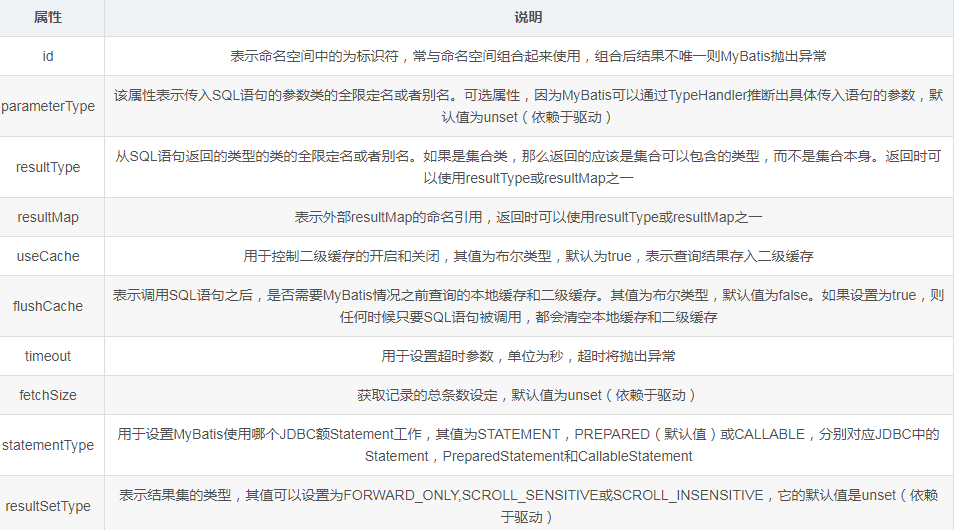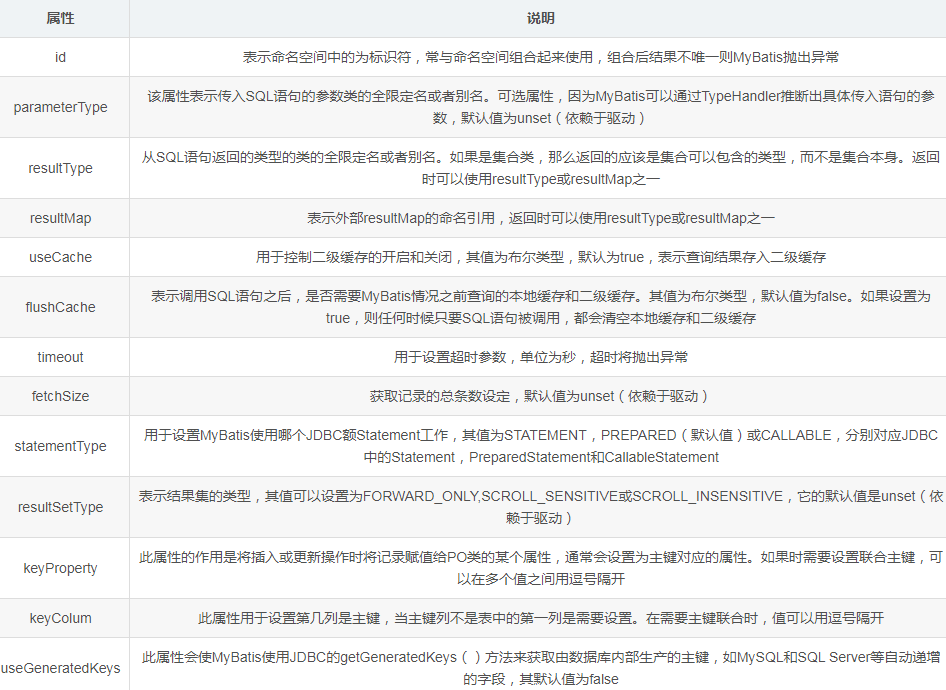你对于mybatis映射文件有多了解呢?下面的文章要给大家讲到的就是和这方面相关的内容,下面一起来详细的看一下吧。
在映射文件当中,mapper元素是映射文件的根元素,其他的标签都是它的子元素。
select
用于映射查询语句,从数据库当中读出数据,组装数据给业务开发人员。
上面的语句当中,唯一标识为findCustomerById。
它接受一个Integer类型的参数,并且返回一个Customer类型的对象。
下面是它的常见属性:

insert
用于映射插入语句,在执行完语句之后,返回一个表示插入记录数的整数。
它的常见属性除了包含select的属性之外,还有另外的三种属性:

实例代码:
<insert id="addCustomer" parameterType="com.itheima.po.Customer" keyProperty="id" useGeneratedKeys="true">
INSERT INTO t_customer(username,jobs,phone) VALUES (#{username}, #{jobs}, #{phone})
</insert>@Test
public void addCustomerTest() throws Exception {
String resource = "mybatis-config.xml";
InputStream inputStream = Resources.getResourceAsStream(resource);
SqlSessionFactory sqlSessionFactory = new SqlSessionFactoryBuilder().build(inputStream);
SqlSession sqlSession = sqlSessionFactory.openSession();
Customer customer = new Customer();
customer.setUsername("keke");
customer.setJobs("student");
customer.setPhone("13553423238");
int rows = sqlSession.insert("com.itheima.mapper.CustomerMapper.addCustomer", customer);
System.out.println(customer.getId());
if(rows > 0) {
System.out.println("您成功插入了"+rows+"条数据");
}else {
System.out.println("执行插入操作失败!!!");
}
sqlSession.commit();
sqlSession.close();
}insert和update有一个子标签selectKey。
下面的话,用selectKey标签来实现主键自动增长,以此来解释它的作用:
<insert id="addCustomer" parameterType="com.itheima.po.Customer">
<selectKey keyProperty="id" resultType="Integer" order="BEFORE">
select if(max(id) is null, 1, max(id)+1) as new newId from t_customer
</selectKey>
INSERT INTO t_customer(id,username,jobs,phone) VALUES (#{id},#{username}, #{jobs}, #{phone})
</insert>selectKey元素有keyProperty,resultType,order和statementType,order属性能够设置成BEFORE和AFTER,BEFORE会先执行selectKey,再执行插入语句,AFTER会先执行插入语句,再执行selectKey。
update和delete
update映射更新语句,执行之后返回一个整数,表示更新的条数。
delete映射删除语句,执行之后返回一个整数,代表删除的条数。
它的属性基本上是和select相同的。
sql
可以用SQL标签定义一段SQL语句,之后,可以用include标签进行重用。
如下:
<sql id="customerId">
FROM t_customer WHERE id = #{id}
</sql>
<select id="findCustomerById" parameterType="Integer" resultType="com.itheima.po.Customer">
SELECT *
<include refid="customerId"/>
</select>resultMap
表示结果映射集,定义映射规则,级联的更新以及定义类型的转换等。
元素结构:
<resultMap id="" type=""> <constructor> <!-- 类在实例化时,用来注入结果到构造方法中--> <idArg></idArg> <!-- ID参数;标记结果作为ID --> <arg/> <!-- 注入到构造方法的一个普通结果 --> </constructor> <id/> <!-- 用来表示哪个列是主键 --> <result/> <!-- 注入到字段或JavaBean属性的普通结果 --> <association property="" /> <!-- 用于一对一关联 --> <discriminator javaType=""> <!-- 使用结果值来决定哪个结果集映射 --> <case value=""></case> <!-- 基于某些值的结果映射 --> </discriminator> </resultMap>
实例代码:
<?xml version="1.0" encoding="UTF-8" ?> <!DOCTYPE mapper PUBLIC "-//mybatis.org//DTD Mapper 3.0//EN" "http://mybatis.org/dtd/mybatis-3-mapper.dtd"> <mapper namespace="com.itheima.mapper.UserMapper"> <resultMap id="resultMap" type="com.itheima.po.User"> <id property="id" column="t_id"/> <result property="name" column="t_name"/> <result property="age" column="t_age"/> </resultMap> <select id="findAllUser" resultMap="resultMap"> SELECT * FROM t_user </select> </mapper>
写一个相应的测试方法:
@Test
public void findAllUserTest() throws IOException {
String resource = "mybatis-config.xml";
InputStream is = Resources.getResourceAsStream(resource);
SqlSessionFactory sqlSessionFactory = new SqlSessionFactoryBuilder().build(is);
SqlSession sqlSession = sqlSessionFactory.openSession();
List
<User> list = sqlSession.selectList("com.itheima.mapper.UserMapper.findAllUser");
for (User user : list) {
System.out.println(user);
}
sqlSession.close();
}运行结果:
DEBUG [main] - ==> Preparing: SELECT * FROM t_user DEBUG [main] - ==> Parameters: DEBUG [main] - <== Total: 3 User [id=1, name=lucy, age=25] User [id=2, name=lili, age=20] User [id=3, name=jim, age=20]
以上的内容你都了解了吗?更多相关知识,可以继续关注奇Q工具网的常见问题栏目来进行了解呢。
推荐阅读:
